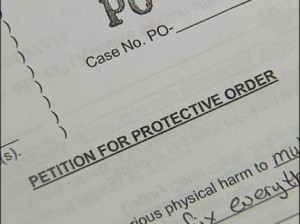This past session, the Maryland legislature enacted a number of changes that affect both victims and perpetrators of domestic violence. Although certainly not a comprehensive overhaul, the new legislation touches on several important areas that affect the public’s ability to obtain and extend both peace and protective orders, as well as enhanced penalties for those who violate such orders.
Peace and Protective Orders are civil orders that an individual may obtain against another individual for committing a prohibited act, such as assault, stalking, or some other form of general harassment (in common parlance, a “restraining order”). These orders are often obtained before criminal charges are formally brought, and provide a measure of protection to victims of abuse or harassment while charges are pending. Whether an individual is able to obtain either a peace or protective order depends on the underlying conduct and the relationship between the persons involved.[1]
Permanent Final Protective Orders
Ordinarily, Final Protective Orders are only effective for one year. However, under certain circumstances a Court may issue a permanent protective order. As the law presently stands, a court is required to issue a permanent final protective order against an individual if
(1) the individual was previously a respondent against whom a final protective order was issued and
(2) the individual was convicted and served a term of imprisonment of at least five years for attempted murder in the first or second degrees, first degree assault, first or second degree rape, first or second degree sexual offense, or attempted rape or sexual offense in the first or second degree.
Bills passed by both the Senate and the House this termexpand the circumstances under which a permanent final protective order may be obtained.[2]
Instead of requiring an individual to serve at least five years before a permanent order may be obtained, the legislature has changed the language to permit the issuance of an order when an individual is sentenced to serve a term of imprisonment of at least five years for specified underlying acts of abuse, and has served at least 12 months. Now, rather than requiring that the respondent actually serve five years in jail – something that will not always occur due to jail overpopulation and credit for good time served – the respondent will only have to have served at least 1 year in jail before the petitioner is able to request a permanent order.
The bills also add the crime of second degree assault to the list of crimes, the commission of which subjects an individual to the issuance of a permanent final protective order. This is an extremely important addendum, as it allows many petitioners to obtain permanent protection before the violence escalates further.
Extensions of Protective Orders
If a petitioner (the person seeking to obtain the peace or protective order) wants to extend a protective order, they have to file a motion and go before the court to do so. However, if a hearing is not held on the motion to extend before the order actually expires, the court cannot do anything – even when the motion was timely filed. In La Valle v. La Valle, 432 Md. 343 (2013), the Court of Appeals held that if a motion to extend a protective order is filed before its expiration, but, for any reason, the hearing on the motion is delayed beyond the expiration of the protective order, that order can no longer be extended.
Senate Bill 434 and House Bill 647, both passed during this past term,require a court to extend a final peace order or a final protective order if, during the term of the order, the petitioner or person eligible for relief files a motion for extension, and to hold a hearing within 30 days after the motion is filed. Given the many snow days we experienced this winter, this provision will help ensure that petitioners are able to obtain the necessary relief even if mother nature causes the courts to close unexpectedly.
Child Witnesses to Domestic Violence
More than 3 million children each year witness domestic violence in their homes.[3] In addition to an increased likelihood that a child will themselves be subject to violence, a number of studies have shown that children who witness domestic violence may suffer emotional and developmental difficulties that are similar to those suffered by children who have been directly abused. Additionally, children who witness domestic violence are far more likely to follow the same path once they become adults; the American Psychological Association has noted that a child’s exposure to the father abusing the mother is the strongest risk fact for transmitting violent behavior from one generation to the next.[4]
Attempting to strike a blow to this continuing cycle of violence, Senate Bill 337 and House Bill 306 add an enhanced penalty for those individuals who commit a crime of violence when the person knows or reasonably should know that a minor, who is at least two years old, is present in a residence within sight or hearing of the crime of violence. Anyone who commits a crime of violence under these circumstances is subject to an enhanced penalty of imprisonment for up to five years in addition to any other sentence imposed for the crime of violence. Importantly, any enhanced penalty imposed under these bills must be separate from and consecutive to any sentence for the underlying crime of violence.
Burden of Proof to Obtain Protective Orders
As the law currently stands in Maryland, in order to grant a final protective order a judge must find by “clear and convincing evidence” that the respondent has committed, and is likely to commit in the future, one of several prohibited acts against the petitioner. According to a 2012 report from the Department of Legislative Services, Maryland is the only state that specifically requires by statute that a petitioner must meet the higher burden of “clear and convincing evidence” to receive a final protective order; 29 other states utilize the “preponderance of the evidence” standard in determining whether to grant a final protective order.[5]
After many years, and amidst widespread criticism from the domestic violence community, the Maryland State Senate and House both recently passed legislation which lowers the standard of proof from clear and convincing evidence to a preponderance of the evidence standard that must be met before issuing or extending final peace orders.
What is a Burden of Proof?
A “burden of proof” is the duty or obligation a person has in a court proceeding to prove their case. There are several different burdens of proof that are used in various court proceedings. Perhaps the most well-known standard is that used in criminal cases, whereby a person must be found guilty “beyond a reasonable doubt.” That means that in order to find someone guilty of a crime, the state must essentially prove that the evidence demonstrates the defendant committed the crime to a certain degree of certainty, and that there is no other logical explanation to explain the underlying event; if the jury has no doubt as to the defendant’s guilt, or if their only doubts are unreasonable, then the burden has been met. If we were to set up the burdens of proof on a football field, to meet this burden you would basically have to score a touchdown; it is the highest burden of proof.
At the other end of the spectrum is the “preponderance of the evidence” standard. This is the standard that is applicable in most civil cases. This standard requires just enough evidence to establish that a fact is more likely true than not true, or more probable than not. If we use the football analogy, to meet this burden you would only have to take the ball just over the 50 yard line. This is the lowest burden of proof one must meet.
In between those extremes lies the “clear and convincing” standard. This standard requires more than just a preponderance of the evidence, but less than would be required to prove something beyond a reasonable doubt; there must be a high probability that something is true in order to meet this burden. Basically, we’re looking somewhere between the 50-yard line and the goal line, although where that line lies is very difficult to determine.
——————-
For more information on peace orders and protective orders in Maryland, please visit the Maryland Courts website at http://mdcourts.gov, or the Maryland Network Against Domestic Violence website at http://mnadv.org.
[1] For a great checklist to help you determine if you are able to file for a peace or protective order, see the Brochure titled “How to File for a Peace or Protective Order” produced by the Maryland Judiciary, located at http://www.courts.state.md.us/courtforms/joint/ccdcdvpo001br.pdf.
[2] Senate Bills 334 and 434; House Bills 309 and 647.
[3] Safe Horizon, https://www.safehorizon.org. Safe Horizon is a victim services agency providing assistance to victims of domestic violence, child abuse, human trafficking, rape, and sexual assault.
[4] American Psychological Association, Violence and the Family: Report of the APA Presidential Task Force on Violence and the Family (1996).
[5] Department of Legislative Services, How States Address Domestic Violence in Selected Areas (2012), available at http://dls.state.md.us.



